Peter MALONE
Portrait of a Lady on Fire
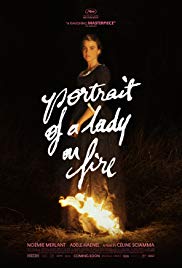
PORTRAIT OF A LADY ON FIRE/ Portrait de la jeune fille en feu
France, 2019, 121 minutes, Colour.
Noemie Merlant, Adele Haenel, Juana Bajramia budget around the, Valeria Golino.
Directed by Celine Sciamma.
The title sounds very elegant. And so is the treatment of this story of portraiture.
The setting is the late 18th century in France, full attention given to costumes and decor. At times, the film looks sumptuous. In fact, the look of the film is very important, the visual style, the invitation to the audience to appreciate colour, compositions, especially in posing at settings, close-ups of the portraits and their impelling realism and communication of character.
In fact, the word aesthetics comes to mind. With the focus on the portraiture and styles, this is an aesthetic study of aesthetics.
The initial focus is on the artist, Marianne (Noemie Merlant), quite a striking and beautiful presence, seen immediately posing herself for a group of young art students. One of them has found her picture of the lady on fire, which provokes audience curiosity as well as memories for Marianne and the flashbacks to the story itself - surprisingly glimpsed only briefly during a picnic on the beach.
The point is dramatically made as Marianne sits on a rowing boat, travelling to an island off the coast, her luggage falling into the water and she diving into retrieve it, left stranded on the beach, having to climb the cliffs, drenched, with her luggage, to go to the mansion where she has been employed to paint the picture of the young lady, daughter of the Countess, who is returning from a Benedictine convent and who has to enter into an arranged marriage with a gentleman from Milan.
Marianne is to act as a companion for Heloise, a reserved young woman, not prone to small talk or humour, not wanting to be painted so that Marianne has to note, sketch, paint, from memory.
There is a great deal of attention to Marianne and the way she paints, the details of the mixing of the paints themselves, the brushstrokes, the continued adjustments, and the extraordinary lifelike results in the portraits. Eventually, Heloise does pose for the paintings, various versions until Marianne is satisfied.
What follows is a slow-burning, initially restrained, mellowing between the two, Heloise smiling, and the awakening of initial affection which leads to passion. This is a theme in all of the films by the writer-director, Celine Sciamma (Water Lilies, Tomboy, Girlhood). Each of the women is transformed by the relationship and the experience. The film won the Best Screenplay at the 2019 Cannes Film Festival.
But, this is the 18th century, an age of arranged marriages, arrangements not to be broken.
The visuals at the end of the film are quite striking, the two women attending a theatre for a music recital, a close-up of Marianne but, demanding in its way, the camera tracking across the theatre to an extreme close-up of Heloise, taking quite some time, and the actress, Adele Haenel, going through the gamut of emotions of sadness and happiness as she listens to the music, the audience supplying what might be going through her mind and emotions, her memories, her present, her future.
1. A film of many nominations and awards? The work of the director, her writing and awards?
2. The title, arresting, the painting itself, the glimpse of the actual situation? Attention to Marianne as artist? Heloise as subject?
3. The late 18th century, lavish costumes and decor? The mansion on the island? The island, the cliffs and the sea? The interiors, the rooms, for painting? Kitchen? The sense of detail? The musical score?
4. The colour photography, the aesthetic compositions, the focus on the characters, posing, painting, the action of the film and the relationship like painting? The lifelike portraits and the vivid creation of close-ups and faces? The importance of aesthetics, aesthetically filmed?
5. The introduction, the girls at the painting class, Marianne posing, serious? The young girl bringing out the lady on fire? Marianne's reaction? The flashbacks to the story?
6. The vivid close-up of Marianne on the boat, the box, overboard, the swimming? The men rolling, the island getting closer? Wet, on the beach, with her boxes and luggage, climbing the cliffs, to the house, Sophie and the door, the welcome, the accommodation, the reception room as her bedroom, settling in, questions of Sophie?
7. The situation in the house, the Countess, the daughter returning from the Benedictines, the preparation for the marriage in Milan? The mother wanting the painting, the daughter not wanting to be painted, Marianne having to observe, note, remember and paint?
8. The arrival of Heloise, her age, her experience of the Benedictines, regretting leaving, not wanting the arranged marriage? Not wanting to be painted? Her sombre dress, serious manner? Going for walks, running to the cliff, the sea? The companionship of Marianne, Heloise gradually mellowing? The picnic outing, her standing by the fire, her skirt catching Fire, her collapse – and the audience memory of having seen the painting?
9. Marianne, painting the portrait, from memory? Heloise relenting? Posing for the picture, sitting, her arms, the striking lifelike nature of the painting?
10. The mother being away, Sophie becoming a companion, Heloise and her posing, a gradual smile, Marianne serious, devoted, wanting Heloise to smile?
11. The growing intimacy, the delicacy of presenting the growing warmth, affection, beginnings of love, the kisses? The aftermath? Heloise and her encouraging Marianne? The sexual encounters? With the prospect of the arranged marriage?
12. Marianne, her being upset about the situation, Heloise's reaction, Marianne's later apology? The continued intimacy, literally letting their hair down?
13. Marian seeing the appearance of Heloise in the white dress, an apparition disappearing? And the final preparation for the marriage, Heloise wearing the white dress?
14. The final posing, the final touches to the portrait? The Countess's return, approving the painting, the envelope and the money?
15. Marianne, the farewell, the last book at Heloise? The teacher and her painting herself from the reflection in the mirror, the gift to Heloise?
16. The return to the art school, the story of seeing Heloise at the music recital? The final image of Marianne looking? The long tracking camera take towards Heloise, the music,
the range of Heloise's reaction, sadness and joy?
Memoir of War/ Le Doleur
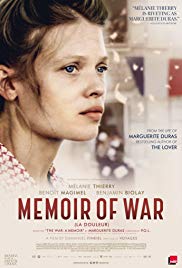
Official Secrets
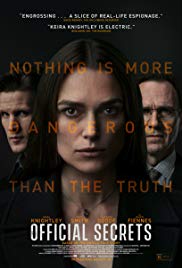
OFFICIAL SECRETS
UK, 2019, 112 minutes, Colour.
Keira Knightly, Matthew Smith, Matthew Goode, Rhys Ifans, Ralph Fiennes, Jeremy Northam, Monica Dolan, Tamsin Grieg, Kenneth Cranham.
Directed by Gavin Hood.
With 24 hour television news cycles, with the demands of Reality Television, with revelations from social media, some of them instant, it is no surprise that feature films and television series are up to the mark in presenting political situations from the immediate past as well as the present up there on the screen.
Interestingly, two significant films were released within a week of each other in the US and in other countries. The Report was a telling drama about compiling the report on the CIA’s use of torture after 9/11, the work of the investigators and the complexity of documents, agent protecting their territories, lies, cover-ups and redactions, even to the defying of the American Congress. Official Secrets is a British film – but with strong critique of American politics in the lead up to the invasion of Iraq.
With revelations after the event, the example here focuses on the information that Saddam Hussein did not have weapons of mass destruction, that there was manipulation of the United Nations Security Council voting, that the invasion might be called illegal (and the final grim statistic before the final credits, the numbers of Iraqis killed and wounded, and the extensive number of British and US military personnel killed and wounded).
This is a story of whistleblowing. As the United States geared up for the invasion of Iraq, supported by British Prime Minister Tony Blair and with the support of much of the media – but with little support from the public, witness the demonstrations against the war – a document came through to an operative in the GCHQ (Government Communications Headquarters) indicating that members of the Security Council from countries like Angola, Chile, Cameroon should be investigated, compromising material found, that could be used to pressure these countries into voting for the invasion.
Keira Knightly, in one of her best performances, plays Katherine Gun who decides that the document in question imperils lives and decides to take it to a friend, involved in anti-war movements. This was in early 2003. The document eventually is leaked to the British newspaper, The Observer, staunch in its support of Blair. Actually, there are very effective scenes in the offices of B Observer, editor, legal adviser, journalists, all involved in intense discussion and, when the documents are published, even more intense discussion.
Amongst the cast in the Observer offices are Matt Smith as Martin Bright, the journalist who wrote the key article with Matthew Goode Is a more restrained journalist and Rhys Ifans, certainly most unrestrained in his condemnation of the editor, his tracking down connections in the United States.
In the meantime, Katherine Gun confesses to the leak, interrogated, threatened, told that the Official Secrets act prevents her talking about her work to anyone, including defence lawyers. Ultimately, the defence lawyer unearths information that the Attorney General of the time changed his advice to Tony Blair after a visit to Washington, that at the time of the leak, his opinion was that the war could be illegal but then he changed it.
Katherine Gun has an interesting background, growing up in Asia, schooled in Taiwan, teaching English in Japan, marrying a Turkish Kurd who is threatened with deportation from England. There are strong scenes between Katherine and her husband, (Adam Bakri who appeared recently in the Australian drama, Slam).
There are many issues in this film: the role and morality of the whistleblower and the motivation for leaks, the legal consequences and restrictions, national security, the role of the press, the freedom of the press. It is fine films like this one that remind audiences of the complexities behind headlines, the labyrinths of security, motivations for political and war action, that the truth is even harder to come by these days than it used to be or, perhaps, seemed to be in the past.
1. The title? British law? Security secrecy?
2. Politics, espionage, public service, security, whistleblowers and the law? The consequences of the revelations?
3. A true story, Katie Gun, her background, growing up in Taiwan, education, teaching English in Japan, the encounter with Yasar, the Kurd, his prospects of deportation, Katie marrying him? Building up a life together? Happy?
4. Cheltenham is ordinary, suburban, travelling to GCHQ, the offices and the Interiors, the desks and workplaces? The musical score?
5. The work of translation, handling secret documents, the role of the supervisors, the friendships within the office, daily routines?
6. The character of Yasar, the background of his life, threats of deportation, his support of Katie, the impact of the situation, his advice?
7. The crucial document, the signature, American pressure on the United Nations, targeting countries for blackmail and pressure? Katie’s shock? The others reading the document, part of their work?
8. Katie going to see her friend, the friend as careful, the document, the caution? The friend giving it to the campaigner, her contacting Martin Bright?
9. The sequences in The Observer rooms, the editor and his staff, deputies, legal advisers, the journalists? Policy for the invasion of Iraq? The arguments? Bright and his talent, Peter more quiet and advisory, and on the ground in Iraq after the invasion? Ed, Bohemian, his rants, against the war, going to the US, obtaining the contacts? The information about the writer of the letter? His urging publication? The eventual publication, the debate? Success? Then the American TV boycotts? The issue of British spelling and the documents seeming inauthentic? The phone calls, trying to track down the writer, being put off? The final information – and the collaboration of authorship between the journalists?
10. Issues of weapons of mass destruction in Iraq, attitude towards Saddam Hussein, memories of the first Gulf War, the first President Bush, George W Bush and his avenging his father? His advisers? The issue of the weapons, whether they existed or not, the desire to invade Iraq?
11. The British issues, the stances of Tony Blair, the Special Relationship with the US, with President Bush? The advice of the attorney general? Lord Goldsmith, the opinion that the war was illegal, his visit to Washington, changing his opinion?
12. The interrogation of all those in the office, Katie denying, looking at the repercussions for the others, telling the truth? The interviews, the detectives, the nature of the interrogation? Time passing, her being taken into custody, in the cell, being released? Yasar and his response?
13. The authorities using Yasar, taking him, to Heathrow, the threat of deportation, the information to Katie, his being released?
14. Katie and lawyers, her being told that to speak to lawyers was also breaking the Officials Secrets Act? The dilemma? Her being followed?
15. Going to the office of Liberty, the meeting with the legal team, the encounters with Emmerson, the discussions, the possible lines of defence? Emmerson, at home, his neighbour, prosecution – and the later scene on the beach and the fishing, Emmerson rejecting him?
16. The discussions about the case, the basis, Lord Goldsmith and his change of opinion, asking for the documents? The issue of dates, Goldsmith’s opinion when the document was released?
17. Katie going to court, Yasar at home, the solemnity of the court, prosecution and defence, the sudden announcement that the case was to be dropped, the judge’s reaction? Emmerson and his statements about the documents?
18. Katie free, the footage of the real Katie and her interview, and whether she would do it again?
19. The invasion of Iraq, the legal issues or not? War crimes? The visuals of the invasion?
20. The final statistics of the dead and wounded, Iraqis, British and American troops?
21. The issue of the need for whistleblowers, rationale, motivations, freedom of the press, the stances of the law?
Marriage Story
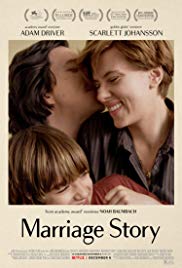
MARRIAGE STORY
US, 2019, 136 minutes, Colour.
Adam Driver, Scarlett Johansson, Laura Dern, Ray Liotta, Alan Alda, Julie Hagerty, Azhy Robertson, Merritt Weaver, Wallace Shawn.
Directed by Noah Baumbach.
The sad truth is that for many decades, many Marriage Stories are actually Divorce Stories. And so with this one, a divorce in close-up, tension between husband and wife, questions about the effect on the young son.
It is not exactly new material but, the screenplay and direction by Noah Baumbach is very strong, very harrowing, emotionally challenging. This has been a feature of his previous films, some of them quite striking, especially The Squid and the Whale. He also directed Margot at the Wedding, Greenberg, Frances Ha,
While audiences know that they are going to see a film about breakup and divorce, this film begins deceptively with statements of admiration by each of the spouses, written so that they can participate in mediation. They are visualised and so the audience can see how the couple met, fell in love, married. And then the tone immediately changes and we see how they have fallen out of love while there are still strong bonds between them.
This is a film of dialogue, a lot of words, words with power in them, many words of conflict between husband and wife. But, while intending to mediate their separation and get the divorce declared, they both eventually go to the lawyers. This is definitely not a pro-lawyers screenplay. Laura Dern is a smilingly dominating lawyer employed by the wife, smilingly no-holds-barred. The husband goes to a seemingly dispassionate lawyer, Ray Liotta. Finding him too hard/ harsh, the husband then goes to a much more genial lawyer, Alan Alda. But, court proceedings seem inevitable and the husband goes back to Ray Liotta.
Much praise for Scarlett Johansson and Adam Driver as the couple. It certainly is one of Scarlett Johansson's best performances, partly sympathetic, partly exasperating, a loving mother, but focused on her ambitions as an actress, focused on Los Angeles where she grew up (with her mother, an amusing turn by Julie Hagerty) rather than on New York where her husband is a much-praised theatre director in a small company but bound for Broadway. Adam Driver has recently given quite a range of excellent performances, from Silence, The Dead Don't Die, Patterson, in the American political drama, The Report and the Star Wars villain).
As the couple argue, consult their lawyers, experience court proceedings, audience sympathies may well veer from one to the other. Each has reasonable desires for the marriage, careers and the future. Each has unreasonable demands, much self-centred concern. However, this is always mitigated by their love for their eight-year-old son and the lawyer is continually reminding them that they have to decide what is best for the boy.
Many of us, at some stage or another, will have become involved with people who are going through divorce. Noah Baumbach's screenplay makes us realise that separation, divorce, court proceedings are not something to be taken on likely (and non-American audiences may gasp, be aghast at the enormous fees demanded by lawyers and the consequences for divisions of property, cost-cutting into savings, the costs determining directions for the future).
Marriage Story cannot be described as an entertainment, it is too close to harsh aspects of real-life, harrowing aspects. But, as a way of leading the audience into contemplating realities, trying to understand how differences could be overcome, healthy compromises made, this expertly made and acted film offers serious challenges.
1. The title? The marriage story? A marriage-breakup story? A divorce story?
2. The world of New York, apartments, theatre, rehearsals and performance? The contrast with Los Angeles, atmosphere, the city of space, family, television production, legal advice for the courts? The musical score?
3. The introduction, the two testimonies read aloud, visualised, the better aspects of each character? For the mediation? Nicole refusing to read hers aloud? Breaking the mediation?
4. Nicole, her character, her interpretation of the situations, the issues of marriage, divorce, custody of Henry? Her initial love for Charlie, marrying him, her bond with her mother and sister in Los Angeles, moving to New York, the theatre, her career, rehearsals, the posters? Her contribution to Charlie’s success as a director? 10 years, careful Henry? Going to Los Angeles, the television series, the filming, the crowd with directors and writers and discussion? Her desire to succeed, to have a career? Agreeing to the mediation, going to Nora for advice, the buildup to argument leading to harsh dispute?
5. Charlie, his life, family background, hard father? His success in the theatre, his creativity, skill with directing, success, possibilities going to Broadway? Marrying Nicole, love for her, his love for Henry and being with him? His shock at the breakup, the threat for divorce? The mediation and its failure?
6. His travels to Los Angeles, back and forth, having time with Henry, the issue of custody, the divorce issues, his need for finance, the grant to the theatre, going to Jay for legal advice, the harsh advice, warning about Nora? His going to Bert, Bert and his friendliness, practical advice, yet the perspective of the court?
7. Nora, blasé in manner, wanting to win, the discussions with Nicole? The contrast with Jay and his severity, Charlie put off? More at home with Bert but frustrated?
8. The effect of Charlie, his range of friends in New York, the members of his company?
9. His good father, with Henry? And yet the continued bonds of friendship and care between Nicole and Charlie?
10. Both Charlie and Nicole, their self-focus, careers, the consequences?
11. Nicole and her family, her mother and her friendliness, the sister and her harsh attitudes?
12. The revelation about Charlie and his affair, the effect? Nicole later going on dates, romance?
13. Henry, his age, experiences in New York, friends, experiencing the tensions, his own character as wilful, wanting stability, to stay on Los Angeles?
14. The court sequences, the bitterness, the divorce, the issue of money, Nora and extra time of custody for Nicole, allowing Charlie the grant?
15. Charlie, his decision to take a job in Los Angeles, the future, possible reconciliation?
Two Popes, The
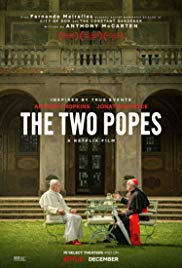
THE TWO POPES
UK/Argentina/Italy/US, 2019, 125 minutes, Colour.
Jonathan Pryce, Anthony Hopkins, Juan Minujin.
Directed by Fernando Meirelles.
There are many reasons, good reasons, to see The Two Popes. Some of them are worth noting before the consideration of religious themes.
• First of all, there is the articulate and elegant writing by British screenwriter, Anthony Mc Carten, who was responsible for the screenplays of The Theory of Everything, a portrait of Stephen Hawking, The Darkest Hour, a portrait of wartime Winston Churchill, Bohemian Rhapsody, a portrait of Freddie Mercury and Queen. He has done his research on Pope Benedict and Pope Francis, drawing on many of their statements as well as using his imagination to create conversations between them. The screenplay is both serious and funny, in English, Spanish, touches of German, Latin, and a significant component of God-language.
• Then there are the performances, two fine actors, Anthony Hopkins a credible Benedict XVI, a ‘behind the scenes’ performance Jonathan Pryce a vigorous Francis. The film has a fine Brazilian director, Fernando Meirelles, whose films include City of God, The Constant Gardener, Blindness – and the opening of the 2016 Rio Olympic Games.
• And the look of the film is strikiing, the stylish photography, the Vatican settings, the 2005 conclave, the Sistine Chapel, the papal apartments, St Peter’s and the Piazza, the Cardinals staying at Santa Marta, avisit to Castel Gandolfo. By contrast, the film brings Buenos Aires alive, first of all in the 21st-century, the outdoors ministry of Cardinal Bergoglio, then black and white flashbacks to his younger years, his vocation decisions, and then a dramatisation of the drastic years of the Generals, especially in the 1970s.
• There are also some surprises with the musical score, not just the expected serious and religious themes, some classical music, but a number of more contemporary songs, creating atmosphere as well as some touches of irony.
Some articles about the film indicate that it is principally conversation between the two popes, their meetings in 2005, Cardinal Bergoglio’s visit to the Vatican in 2012 to persuade the Pope that he should resign as Archbishop of Buenos Aires. While this is at the core of the film, there is a great deal more.
• Some of the issues that the conversations highlight include the stances of each of them concerning belief and doctrine, the traditional teachings of the church, contemporary moral issues. Part of the drama is that they do not see eye to eye on some of these issues, the difficulties of combining authority and tradition with pastoral demands. But, as indicated earlier, there is quite a deal of God-language, discussions about faith and prayer, the two men devout, a confession sequence, Benedict to Francis, which takes the film beyond ordinary dialogue.
It will be interesting after the film’s release, in cinemas first and then on Netflix, making it more immediately available all around the world, to hear the comments of those who favour John Paul II’s and Pope Benedict’s perceptions of the church compared with those who tend, enthusiastically, to favour Pope Francis and his evangelisation outreach. The differences between the two popes are made quite clear early in the film but, as they converse, with strong initial tensions, as they get to know each other, listen to each other’s stories, prepare the way for Benedict’s resignation and its consequences, there is a great deal more in the meeting of minds and hearts.
• Because the film is very sympathetic to Pope Francis (not neglecting the criticisms of him when he was Jesuit provincial in Argentina and was seen to side too much with the authorities), the portrait of him is more extensive than that of Pope Benedict. As indicated, we are taken back quite extensively to Cardinal Bergoglio’s life, black-and-white photography of him as a young man, searching for his vocation, a recurring image of him sitting alone in the mountains reflecting, the possibility for marriage, his choices and entry into the seminary (filmed in black and white). Audiences who might not be fully aware of the controversy about Bergoglio and the generals, his turn as provincial wanting to protect the lives of the Jesuits, asking them to close some of their ministries because they were considered too dangerous, some defiance and him on the part of social-minded, confreres, will find this section of the film quite arresting. But, there are sequences enabling Cardinal Bergoglio to admit mistakes publicly, to be sorry for the decisions that he had made, to reconcile with some of his conferences. These experiences enable him, as Archbishop of Buenos Aires to reach out to the poor.
• The Bergoglio who emerges from these sequences is an educated man, a religious leader, a man who admits mistakes, who is transformed into a social-minded pastor, an extrovert who is comfortable in meeting all kinds of people, enjoying their company (especially in supporting his football team, San Lorenzo), familiar with aspects of popular culture. (An amusing episode occurs where Benedict tells Francis that his piano CD was made it Abbey Road leads to a talk about the Beatles!)
• By contrast, there is no visual portrait of Benedict’s life. There are verbal references, and his saying that he was more introverted, bookish, intellectual, and had not any of the pastoral outreach of the Bergoglio. (Audiences may well enjoy a sequence where the two are in a side sacristy of the Sistine Chapel, tourists arriving, Benedict’s decision for the two to walk through the Chapel, the tourists becoming excited – and a number of selfies!).
And so, the film and its narrative are multi-layered.
• The narrative goes back to the death of John Paul II and the preparations for the subsequent conclave, sequences of Cardinals discussing with each other, the possibility of Cardinal Bergoglio being elected, Cardinal Martini of Milan advising colleagues not to vote for him, Cardinal Ratzinger seemingly eager enough to become Pope. There is a dramatic tension in the conclave – the details of some of the voting, the black smoke, the white smoke, the emergence of Benedict, and Cardinal Bergoglio going back home, but seemingly steady pontificate.
• Towards the end of the film there will be the 2013 conclave, the discussions, the assembly, the voting, the acceptance – and Francis not wanting special shoes, not wanting the ermine cape (“the carnival is over�), emerging to the cheering crowds and simply saying, “Buena Sera� (good evening).
Audiences interested in the contrast between the approaches of Benedict and Francis will find these sequences illustrating the different points of view, the needs of the church in the 21st-century, the issue of clear guidance and authority compared with a more horizontal metaphor of the church rather than the hierarchical pyramid, pastoral needs and evangelisation.
• Which means then that involved Catholics, with faith and loyalty, will find this two hour immersion into the life of the church of great interest, of encouragement. For nominal Catholics, the film offers an occasion, even an invitation, to more thought and assessment, re-assessment. It will be the same for lapsed Catholics. For ecumenical and interfaith audiences, the drama is both attractive and thought-provoking. And for non-religious audiences, they will appreciate good drama, good writing and performances, character studies – and an opportunity to give further thought to the credibility, life and mission of the Catholic Church.
But, audiences will have two, at least, aspects of conversation about the film.
• Questions arise, as they have done during the two pontificates, about tradition and openness of the church. Vatican II was about opening the windows and renewal and updating. John Paul II was committed to doctrinal orthodoxy but also to extensive world travel, showing the human, and frequently genial, face of the church. Benedict, had to move out of his preference for reserve, and continue John Paul II’s two aspects of church life, authority as well as the human face. With Francis, and this is very strongly highlighted in the film, the tradition is important but the pastoral interpretation of tradition is the great challenge, the realities of evangelisation in the contemporary world, pastors and their having “the smell of the sheep�.
• Most most audiences will enjoy the way these emphases are illustrated, from his whistling Abba’s Dancing Queen (which actually is also used in the background as the fully robed Cardinals enter the Sistine Chapel for the conclave!), some Latin American musical background, Pope Francis trying to book a ticket to Lampedusa online and failing (the film actually opening and closing with this episode), buying pizza in a shop near the Vatican (and later persuading a Vatican authority to go out and get some takeaway pizza for himself and Benedict to enjoy), Francis and his TV football watching, his jokes. Benedict does not always get them, then realises that they are jokes – and, amusingly, when he himself makes a joke, not so funny, he tells Francis that this was a German joke and German jokes are not meant to be funny! So, the human face, the humour.
In these senses, The Two Popes might be seen as an exercise in evangelisation to the world in the Francis’ mode.
• At the core of the conversation is Benedict’s resignation. There is a dramatic buildup in so far as Cardinal Bergoglio travels to the Vatican, continually tries to persuade Benedict to accept his resignation. Because of the differences in perspective between the two, Benedict says that the resignation might be interpreted as a criticism of Benedict’s direction of the church. So, there is much discussion to illustrate the different perceptions of each of the men.
• However, with the issues of mismanagement in the Vatican bank, with the pressures of being Pope, Benedict’s advancing age, he turns the tables and shocks Bergoglio with the news that he wants to resign. Interesting that Bergoglio thinks that this is impossible, unthinkable. But, audiences will find fascinating this dramatising of the two points of view, the continuing conversations, Benedict reasoning, Francis’s change of mind – with a wry observation put in Benedict’s mouth that the papal successor usually acts as a corrective to the previous Pope and he will be glad to be alive to see his corrective! There are several mentions that rather than compromise, well-considered change is preferable.
• The bonds between the two men and increasing mutual understanding prepare them for the actual resignation, the amazement throughout the world, the next conclave (and a scene where Benedict watches the white smoke on television in the papal apartment), the emergence of Francis.
The film then takes the advantage of quoting Francis’s words of social concern, his first trip outside the Vatican to Lampedusa to meet refugees who had sailed across the Mediterranean from North Africa, images of small boats and overwhelming waves, the faces of those in need. To that extent, the ending is venture into preaching, social preaching.
Given the significance of the two Popes themselves, the papacy in the Catholic Church at the beginning of the 21st-century, the continued dialogue between tradition and pastoral outreach, the questions of what the Catholic Church should be and will be, The Two Popes is certainly worth watching – and watching again.
Our Time Will Come
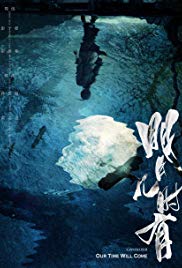
OUR TIME WILL COME
China, 2018, 130 minutes, Colour.
Xun Zhou, Eddie Peng, Wallace Huo, Deannie Ip, Tony Ka Fai Leung.
Directed by Ann Hui.
The Chinese film industry has been strong on producing films about the Japanese invasion and occupation in the 1930s, the siege of Nanking, the resistance during World War II. This is another strong example, directed by veteran Hong Kong Director, Ann Hui.
The narrative has three interconnected thrusts.
One focus is on a young woman, a teacher, living with her mother, proposed to by a chef, her putting it off because of the war, his going to work for the Japanese, undercover as a spy.
The initial action concerns intellectuals in Hong Kong and resistance movements organising their escape, over 800. One of the intellectuals, a poet, whose words are cited throughout the film, stays with the young woman and her mother. There is an attempt on the author’s life but he is rescued by the resistance, taken to a boat with many others, taken to the mainland and a convoy established to get them through to safety – even with an encounter with rebels and a deal done with them to be allowed to pass through their territory.
The young woman, because she is being caught up in the action, and encounters one of the rebels and is urged to join the group in Hong Kong. She does, her mother worried about her. The film shows the activities, communicating messages – and her mother offering to carry messages to save her daughter. The mother is arrested, pleading ignorance and inability to write, but is imprisoned, pleading that she does not know the associate arrested with her, and then she is executed.
The film shows the difficulties of Hong Kong surviving during the Japanese occupation, the dangers, the streets, the shops and suppliers, the lack of food, even a wedding continues in this atmosphere.
The film shows the activities of the outlaw rebel, his personality, his defying the Japanese by turning up at a meeting and causing some mayhem.
The film also shows the experiences of the young man who has gone to work with the Japanese, his bonding through poetry with the Japanese chief, yet his getting information, passing notes to secretaries who can get the information out, maps for targeting for bombing. Eventually, his role is discovered, his chief slashing him in the legs with his sword but the man defiant and allowed to go.
This is an opportunity to see resistance in action, a reminder of the Japanese occupation and its effects – and the long Chinese memory.
Fury of a Patient Man, The
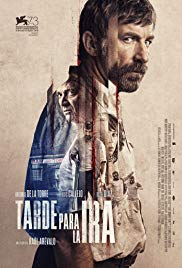
THE FURY OF A PATIENT MAN
Spain, 2016, 92 minutes, Colour.
Antonio de la Torre, Luis Callejo, Ruth Diaz, Raul Jimenez.
Directed by Raul Arevalo.
This is a vengeance drama from Spain. It opens with an escape from a robbery, a chase, shooting, a death and a crash.
For the first half hour, this is rather a slow burn but within time the audience realises what has happened. The initial chapter is called Bar and the next chapters are named after the three central characters. Anna works at a bar, has a young child, her lover is in prison as the getaway driver for the crime. Her brother also works at the bar. However, a stranger comes into the area from a more wealthy section of the city, spends a lot of time with Anna, begins a sexual relationship. This has quite an effect on her as she visits her husband in prison and, when he is released, she takes refuge in the stranger’s house.
We appreciate that the stranger is investigating the crime, the connection with Anna, and a flashback to the brutal murder of his fiancee during the crime.
When the prisoner is released, he is suspicious. However, the stranger takes him in charge, forces him to make the connections with the other members of the robbery, interrogating them, then becoming more and more brutal as he demands answers.
1. A vengeance film? The first 30 minutes and the audience appreciating what is happening? The transition with the release from prison? Jose and his using the prisoner to make connections with the criminals? The finale and his brutal vengeance?
2. The atmosphere, the bar, the chapters with each of the central character’s name is? Jose and his hanging around the bar? The attraction to Anna, yet wanting to interrogate her and get leads? The presence of her brother?
3. The robbery, the escape, the chase, the crash? The shooting? The flashbacks – and the brutal murder of Joe says fiancee?
4. Jose say and Anna, the relationship, her child? Visiting her partner in prison? The devotion to him? His release? Sexual encounter, his suspicions? Her leaving for Jose’s house with her daughter?
5. Curro, his part in the crime, in prison? His child? The visits of his partner? His suspicions of her on release? The control by Jose, the explanations of what happened, Curro and his fear, taking José to the gym, the chattering man, Jose stabbing him? The paying for the T-shirts? The further connections, the man living with his wife and child, the hospitality, the conversation after the meal, José, the fear of the man, shooting him?
6. The end, Jose having achieved his vengeance? The effect? Curro and his survival? Anna and her child?
7. The theme of revenge – and whether it satisfies not? Compensates or not?
Unleashed
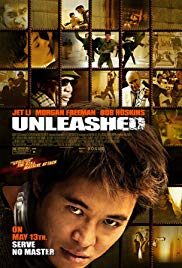
UNLEASHED
France/US/ UK, 2005, 103 minutes, Colour.
Jet Li, Morgan Freeman, Bob Hoskins, Kerry Condon, Vincent Regan, Dylan Brown, Tamer Hassasn, Phyllida Law.
Directed by Louis Leterrier.
It is very hard to put together the Jet Li of his Hong Kong films and his fine lead role in Zhang Yimou's Hero with the Jet Li of his Hollywood and western action thrillers like Kiss of the Dragon, The One, Cradle 2 the Grave. These latter are potboilers of the most basic kind one is tempted to say, after looking at some of the brutally staged fights, of the most base, violent kind.
Unleashed seems to be two films which gradually converge. The foremost story involves Li as a kind of wild child brought up in England as a lethal fighter, for rich patrons to attend a fight club to the death. His guardian is played by Bob Hoskins with few holds barred. This is an ugly, thuggy film.
Then there is the other film where Li takes refuge with a kindly blind piano tuner and his stepdaughter. Li can at last see another kind of life as well as discover the dastardly death of his mother and why he has been a prisoner. Since the blind man is played by Morgan Freeman, he brings great dignity and presence (and his fine voice) to a film that you wouldn't expect to find him in.
Of course, the two strands come together again for a last bout of violence. The trouble with this kind of entertainment (unlike Jackie Chan who opts for martial arts and fun) is that it is so often brutal and ugly.
1. The title, the literal application for Danny, aggressive when unleashed?
2. The French background, Luke Besson and his story, his style? The director and his range of action films, American films? The international cast?
3. A vehicle for Jet Li? His athleticism, martial arts, the brutal fights?
4. The London setting, the loan sharks and their world, the various companies and repayment of loans, the brutal cage fights, the contrast with the music tuner, the academic world of music? The interconnections? The musical score?
5. The initial focus on the violence, the quiet with the scenes of music and Danny learning to live an ordinary life, the dramatic return to violence?
6. Danny, the mystery of his background, Bart and his having him on a leash, taking him on money collections, unleashing him, the violence, letting him be brutal, his being an educated, following Bart’s commands? His puzzle about his mother?
7. Bart, the thug, his associates, the various companies and collecting the money from the loans? The jewellers, the antique furniture creators? His treatment of Danny, unleashing him? The entrepreneur watching, making the proposal, the cage fight? Danny, the first fight and quick win? The entrepreneur wanting to exploit him?
8. The crash, the shooting, Danny escaping, presuming Bart was dead?
9. Waiting with the antiques, Sam and his arrival, blindness, music, tuning the pianos, Danny's attraction? The melody in his mind? Returning after the shooting, Sam and his kindness, taking him in, Victoria, at home, his timidity, fright, under the bed, the food, gradually joining Sam and Victoria? The learning experiences, the discoveries? Gradually revealing his story? The desire to learn about his mother? The shopping? The cooking? The peaceful atmosphere of the film between the fights?
10. Sam, his story, pianist, Carnegie Hall, blind? Piano tuning? Kindly? The encounter with Danny, bringing him home, opening up different worlds to him, reading, music, shopping, cooking, Sam as a benign father figure? Victoria, her relationship with Sam, coming to London for the music, sharing the music with Danny, the small piano? Their duets? The effect of Danny on her? Preparing for her recital?
11. Danny, the chance encounter with Bart's thug, but still alive, putting the leash on him, taking him to the cage fight, Danny not wanting to hurt people, the brutality, the number of opponents, his self-defence and destroying them?
12. Bart, the photos, evoking memories? The music, his mother playing the piano? Going to the Academy, the documents, memories coming back, the music notes? Bart killing his
mother? Danny and the confrontation was about, retribution?
13. Victoria, her recital, going back to New York, Sam inviting Danny?
14. An unusual blend of the brutal with the gentle?
Howard Lovecraft and the Frozen Kingdom

HOWARD LOVECRAFT AND THE FROZEN KINGDOM
Canada, 2016, 83 minutes, Colour.
Voices of: Keifer O' Reilly, Michelle O' Reilly, Christopher Plummer, Tyler Nichol, Sean Patrick O' Reilly, Summer O' Reilly, Phoenix O' Reilly, Harmony O' Reilly, Jane Curtin, Doug Bradley, Ron Perlman.
Directed by Sean Patrick O' Reilly.
This is a Canadian animated film, the animation style of characters and situations back into that of the hotel Transylvania series.
The film opens with a quotation from novelist H.P.Lovecraft about fear and fear of the unknown. This film takes up some of his stories and characters, focusing on the young Howard Lovecraft, in the care of his mother, visiting his father in a mental institution, being warned about the book the necromantic on. His father gives him a star – and he goes home, his mother giving him his father’s direct to read, a magical transformation and his falling down a hole, akin to Alice, but to the Frozen c Kingdom, not exactly a Wonderland.
The film could be of interest to those who like the work of Lovecraft. But, in its style, it seems to be geared to a younger audience, the character of Howard himself, the creatures that he encounters in the Kingdom, the wide range of adventures, likeable characters, he is some characters.
Charlie's Angels/ 2019
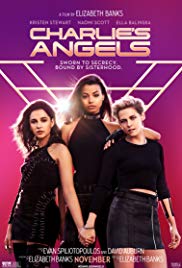
CHARLIE’S ANGELS
US, 2019, 118 minutes, Colour.
Kristin Stewart, Naomi Scott, Ella Balinska, Elizabeth Banks, Patrick Stewart, Sam Claflin, Jonathan Tucker, Chris Pang, Djimon Hounsou.
Directed by Elizabeth Banks.
More Charlie’s Angels!
They made quite a television hit in the 1970s, female agents, comparisons with male agents, the different gender perspectives. And the hair and the glamour of the times. They made another reappearance with some films at the beginning of the 21st-century, much the same plots, but a much more sharpened and assertive female perspective while still an emphasis on glamour.
So, it is a surprise to find yet another reboot. It is the work of Elizabeth Banks, significant actor for many years and moving into direction with some of the Pitch Perfect films. She has written the screenplay here. She is also the director. She is also one of the central characters – a former Angel become Bosley. And, this time there is a proliferation of Bosleys all around the world (men and women), seen at an early sequence where the veteran Bosley, a smiling (smilingly sinister) Patrick Stewart being retired and celebrated at a farewell party.
There is a prologue situation in Brazil introducing the new set of angels. Then we move to Hamburg and a familiar situation where scientific developments, able to control energy throughout the world, but being subverted into weapon power, the subject of stealth, blackmail, black market sales. We see quite a bit of Hamburg, especially during one of those spectacular car chases with both cars having machine gun power and beyond!
But, while we have met Sabina in Brazil, we now meet Jane and are introduced to Elena (Naomi Scott who was the charming Jasmine in Aladdin) who is a top scientist at the project. When she is the target in that car chase, the angels and their organisation take over the investigation and the retrieval of the energy source.
Sabina is Kristin Stewart, a rather brittle kind of character, physical prowess, able to perform seductively but, as she says, lacking that filter which gives her empathy. Much more empathetic is Jane, British, formerly employed by MI6. She is played with quite some energy by Ella Balinska. While Elena helps in the adventures, she begins timid, gains in strength, is abducted and held to ransom – but, of course, is invited to become an Angel herself.
The main action takes place in Istanbul – also picture perfect with some sinister venues.
So, it is certainly no life-changing entertainment but it seems very James Bond dish, very Man from Uncle-ish -but, really, when you think of it, it is very Charlie’s Angel-ish.
1. The popularity of the television series? The significance of women agents? The atmosphere of the 1970s and secret agent shows? The reboot in 2000? The 21st-century interpretation of the role of women, law and order, crime-fighting? A reboot almost 2 decades later?
2. The role of the director, female perspective, the writing the screenplay, her performance and presence throughout the film, enthusiasm?
3. The cast, the three young women, Sabina as a brittle character, able to perform in her role, but lacking the filter of empathy? Jane, MI6 and the background? Elena, intelligent, her working in the company, timid, becoming more involved, becoming an angel?
4. The setting, Brazil, the setup with Jonny (Chris Pang), flirtation, the bodyguards, the confrontations, the escape? The introduction to each of the characters? Sabina, physical prowess, seductive acting? Creating the atmosphere?
5. Bosley, the farewell, the gathering, the speeches, the toasts, the International Bosleys? His 40 years in the organisation? His expectations? His retirement? Audience surprise that he turned out to be the villain, his ambitions, ruthlessness, know-how? Intervention at the end, his domination of Brock, wanting the power, his agents, wrote back and his ruthlessness? The women defeating him? His comeuppance?
6. The basic situation, scientific background, the means of energy control, Elena and her work, her boss and his wanting to deceive the owner, his absconding, going to Istanbul, setting up the deal, his being killed?
7. The Hamburg sequences, the laboratories, the offices, Helena and her work, her workmate? Security? Her informing the authorities? Bosley and her taking charge, knowing all the background, access? Elena being followed, the target, Rodak and his brutality, the car chase, the firepower, the final confrontation, Jane and Elena going into the River, the rescue? Rodak and his reappearing, hitman for sale, turning against Brock, working for Bosley? The revenge of the angels, the fights, his being impaled?
8. Brock, wealthy, betrayed, his party, weak, collapse?
9. The atmosphere of Istanbul, the scenic aspects? Going to the charity worker, the gifts, Jane reconciled, her help, helping Helena after the ordeal?
10. The races, the surveillance and the various disguises, Sabina on horse, the pursuit, the destination, discovering the assembly? The shootings? The angels and their attack? Bosley leaving, their suspicions, the older Bosley turning up, rescuing Helena, shooting? Suspicions, the revelation of the truth?
11. The party and Switzerland, the angels and entry, dancing, Elena hostage, the confrontations with Bosley? The final fights?
12. Elena, her achievement, being invited to become an Angel, the credits sequences, her training, achievement?
13. The way this film connected with the previous films, the voice of Charlie, the new Charlie and the appearance of Jaclyn Smith? The overview of history – and the photos with Drew Barrymore, Cameron Diaz…?